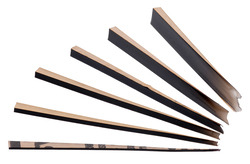Support » Custom Laser Cutting Guide »
4. Limitations and issues to consider
 |
The kerf of our laser is roughly 0.007" – 0.01" which causes parts to be slightly smaller and have larger holes than how they are drawn. |
|---|
 |
An example of melting along sharp angles for various thicknesses of acrylic (1.5 mm to 12 mm). |
|---|
While the possibilities of things that you can create using our laser cutting service may seem endless, there are still some limitations that you should keep in mind when considering our laser-cutting service:
- We can only cut two-dimensionally – no 3D designs, or beveled edges.
- All laser-cut dimensions will vary slightly due to the laser’s kerf (beam width). While we typically expect a kerf width of ~0.007″ – 0.010″, we do not guarantee any particular tolerance as there are many factors that affect the exact kerf size (material type, material thickness, material flatness, size and shape of your part and overall layout, and more).
- Having cut lines too close together can sometimes cause the material between the cuts to break, melt, warp, or become brittle due to the heat from the laser. This includes parts with sharp angles that narrow into a sharp tip. We generally recommend having no areas that are narrower than the thickness of the material you are using.
- The laser’s beam is cone-shaped which causes the parts to have a slight (1-2 degree) taper. The kerf width is smaller on the front than it is on the back of the material.
- The laser’s beam is not perfectly circular, which means squares will not be perfectly square, and circles are not perfectly circular (for parts that need to be perfectly circular, we suggest cutting smaller holes and cleaning them up with a drill).
- Most sheet material thicknesses can vary slightly, and different materials have different thickness tolerances. We cannot promise anything beyond what the material manufacturers do, nor do we offer material pre-screening.
- Laser-cut steel is not guaranteed to be free of dross and burring, and we do not offer any post-cutting services such as deburring, tumbling, polishing, bending, welding, anodizing, or coating.
- Some materials, like acrylic, come with a protective film or paper masking layer applied to the surface, while other materials (e.g., ABS, Delrin, styrene, MDF, plywood, etc.) do not. We typically cut and ship the materials as they are when we receive them, but can add masking upon request (we charge more to mask materials).
- Parts cut from paper-masked parts will ship with the masking still on (we have a video that shows an easy way to unmask acrylic).
- Parts cut from materials without masking may have burn markings from the cutting process.
- Some materials will have noticeable discoloration or char on the edges from the laser, such as wood, paper, rubbers, and fabrics. For more material-specific info, please see our materials page.
- The material sits on a metal grid during cutting. When the laser cuts through the material, it hits the grid and bounces back and hits the bottom of the material, causing a small dent or mark. The backs of the parts will usually have small dents along the cut edges of the part wherever the laser, grid, and material meet.



